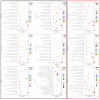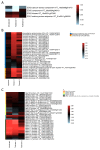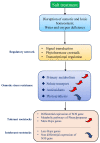Transcriptomic Analysis Elaborates the Resistance Mechanism of Grapevine Rootstocks against Salt Stress
- PMID: 35567166
- PMCID: PMC9103662
- DOI: 10.3390/plants11091167
Transcriptomic Analysis Elaborates the Resistance Mechanism of Grapevine Rootstocks against Salt Stress
Abstract
Grapes are subject to a wide range of climatic conditions during their life cycle, but the use of rootstocks can effectively ameliorate the effects of abiotic stress. However, the tolerance mechanism of different grape rootstock varieties varies under various stresses, and systematic research on this aspect is limited. On the basis of previous research, transcriptome sequencing was performed on three tolerant grape rootstock varieties (3309C, 520A, 1103P) and three intolerant grape rootstock varieties (5BB, 101-14, Beta). In total, 56,478,468 clean reads were obtained. One hundred and ten genes only existed in all combinations during P1 with a downregulated trend, and 178 genes existed only in P1 of tolerant grape rootstock varieties. Salt treatment firstly affected the photosynthesis of leaves, and tolerant varieties weakened or even eliminated this effect through their own mechanisms in the later stage. Tolerant varieties mobilized a large number of MFs during the P2 stage, such as hydrolase activity, carboxypeptidase activity, and dioxygenase activity. Carbon metabolism was significantly enriched in P1, while circadian rhythm and flavonoid biosynthesis were only enriched in tolerant varieties. In the intolerant varieties, photosynthesis-related pathways were always the most significantly enriched. There were large differences in the gene expression of the main signal pathways related to salt stress in different varieties. Salt stress affected the expression of genes related to plant abiotic stress, biotic stress, transcription factors, hormones, and secondary metabolism. Tolerant varieties mobilized more bHLH, WRKY, and MYB transcription factors to respond to salt stress than intolerant varieties. In the tolerant rootstocks, SOS was co-expressed. Among these, SOS1 and SOS2 were upregulated, and the SOS3 and SOS5 components were downregulated. The genes of heat shock proteins and the phenylalanine pathway were upregulated in the tolerant varieties. These findings outline a tolerance mechanism model for rootstocks for coping with osmotic stress, providing important information for improving the resistance of grapes under global climate change.
Keywords: grape; rootstock; salt stress; signal transduction.
Conflict of interest statement
The authors declare no competing interest.
Figures







Similar articles
-
Global transcriptome analysis of grapevine (Vitis vinifera L.) leaves under salt stress reveals differential response at early and late stages of stress in table grape cv. Thompson Seedless.Plant Physiol Biochem. 2018 Aug;129:168-179. doi: 10.1016/j.plaphy.2018.05.032. Epub 2018 May 31. Plant Physiol Biochem. 2018. PMID: 29885601
-
Whole-genome re-sequencing, diversity analysis, and stress-resistance analysis of 77 grape rootstock genotypes.Front Plant Sci. 2023 Feb 9;14:1102695. doi: 10.3389/fpls.2023.1102695. eCollection 2023. Front Plant Sci. 2023. PMID: 36844076 Free PMC article.
-
The Expression of Aroma Components and Related Genes in Merlot and Marselan Scion-Rootstock Grape and Wine.Foods. 2022 Sep 9;11(18):2777. doi: 10.3390/foods11182777. Foods. 2022. PMID: 36140906 Free PMC article.
-
Comparative metagenomic analysis reveals rhizosphere microbial community composition and functions help protect grapevines against salt stress.Front Microbiol. 2023 Feb 20;14:1102547. doi: 10.3389/fmicb.2023.1102547. eCollection 2023. Front Microbiol. 2023. PMID: 36891384 Free PMC article.
-
Current progress in research focused on salt tolerance in Vitis vinifera L.Front Plant Sci. 2024 Feb 8;15:1353436. doi: 10.3389/fpls.2024.1353436. eCollection 2024. Front Plant Sci. 2024. PMID: 38390291 Free PMC article. Review.
Cited by
-
Analysis of GATA transcription factors and their expression patterns under abiotic stress in grapevine (Vitis vinifera L.).BMC Plant Biol. 2023 Dec 2;23(1):611. doi: 10.1186/s12870-023-04604-1. BMC Plant Biol. 2023. PMID: 38041099 Free PMC article.
-
Comparative physiological and co-expression network analysis reveals potential hub genes and adaptive mechanisms responsive to NaCl stress in peanut (Arachis hypogaea L.).BMC Plant Biol. 2025 Mar 6;25(1):294. doi: 10.1186/s12870-025-06311-5. BMC Plant Biol. 2025. PMID: 40050719 Free PMC article.
-
Overexpression of TaPIP1A enhances drought and salt stress tolerance in Arabidopsis: cross-species conservation and molecular dynamics.Front Plant Sci. 2025 Jun 2;15:1425700. doi: 10.3389/fpls.2024.1425700. eCollection 2024. Front Plant Sci. 2025. PMID: 40528925 Free PMC article.
-
Overexpression of a Malus baccata (L.) Borkh WRKY Factor Gene MbWRKY33 Increased High Salinity Stress Tolerance in Arabidopsis thaliana.Int J Mol Sci. 2025 Jun 18;26(12):5833. doi: 10.3390/ijms26125833. Int J Mol Sci. 2025. PMID: 40565296 Free PMC article.
-
Beyond the lab: future-proofing agriculture for climate resilience and stress management.Front Plant Sci. 2025 Jun 13;16:1565850. doi: 10.3389/fpls.2025.1565850. eCollection 2025. Front Plant Sci. 2025. PMID: 40584856 Free PMC article. Review.
References
-
- Keller M. Managing grapevines to optimise fruit development in a challenging environment: A climate change primer for viticulturists. Aust. J. Grape Wine Res. 2010;16:56–69. doi: 10.1111/j.1755-0238.2009.00077.x. - DOI
Grants and funding
LinkOut - more resources
Full Text Sources
Miscellaneous

